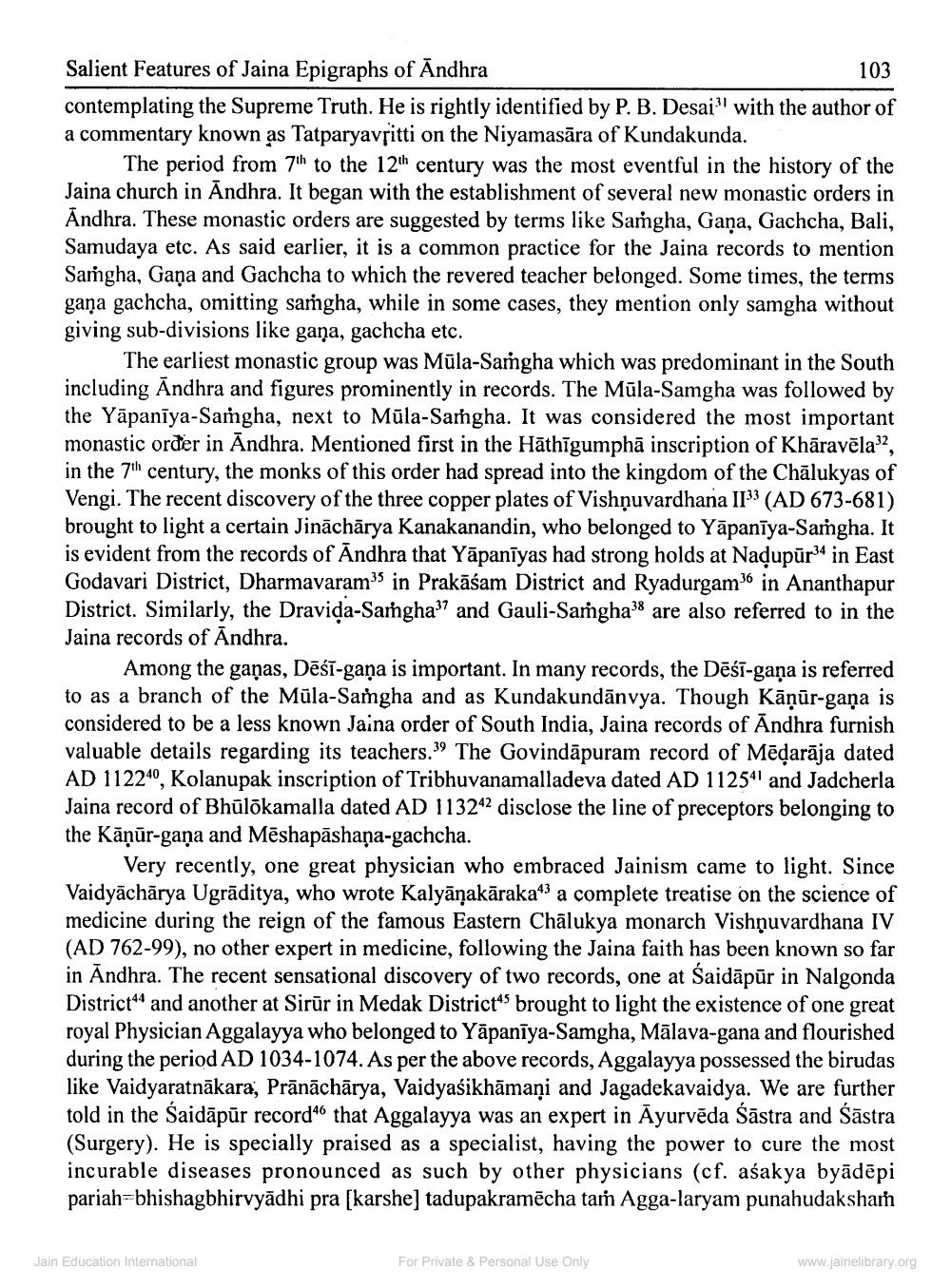________________
Salient Features of Jaina Epigraphs of Andhra
103 contemplating the Supreme Truth. He is rightly identified by P. B. Desai" with the author of a commentary known as Tatparyavritti on the Niyamasāra of Kundakunda.
The period from 7th to the 12th century was the most eventful in the history of the Jaina church in Andhra. It began with the establishment of several new monastic orders in Āndhra. These monastic orders are suggested by terms like Samgha, Gana, Gachcha, Bali, Samudaya etc. As said earlier, it is a common practice for the Jaina records to mention Saṁgha, Gana and Gachcha to which the revered teacher belonged. Some times, the terms gana gachcha, omitting samgha, while in some cases, they mention only samgha without giving sub-divisions like gana, gachcha etc.
The earliest monastic group was Mūla-Samgha which was predominant in the South including Andhra and figures prominently in records. The Mūla-Samgha was followed by the Yāpanīya-Samgha, next to Mūla-Sargha. It was considered the most important monastic orđer in Andhra. Mentioned first in the Hāthīgumphā inscription of Khāravēla??, in the il century, the monks of this order had spread into the kingdom of the Chālukyas of Vengi. The recent discovery of the three copper plates of Vishnuvardhana II” (AD 673-681) brought to light a certain Jināchārya Kanakanandin, who belonged to Yāpanīya-Samgha. It is evident from the records of Andhra that Yāpanīyas had strong holds at Nadupūr34 in East Godavari District, Dharmavaramin Prakāśam District and Ryadurgam36 in Ananthapur District. Similarly, the Dravida-Sarngha? and Gauli-Samgha38 are also referred to in the Jaina records of Andhra.
Among the gaņas, Dēsī-gaña is important. In many records, the Dēśī-gaña is referred to as a branch of the Müla-Samgha and as Kundakundānvya. Though Kāņūr-gana is considered to be a less known Jaina order of South India, Jaina records of Āndhra furnish valuable details regarding its teachers.39 The Govindāpuram record of Mēqarāja dated AD 112240, Kolanupak inscription of Tribhuvanamalladeva dated AD 112541 and Jadcherla Jaina record of Bhūlākamalla dated AD 113242 disclose the line of preceptors belonging to the Kāņūr-gana and Mēshapāshana-gachcha.
Very recently, one great physician who embraced Jainism came to light. Since Vaidyāchārya Ugrāditya, who wrote Kalyāṇakāraka43 a complete treatise on the science of medicine during the reign of the famous Eastern Chālukya monarch Vishnuvardhana IV (AD 762-99), no other expert in medicine, following the Jaina faith has been known so far in Andhra. The recent sensational discovery of two records, one at Saidāpūr in Nalgonda District and another at Sirur in Medak Districtos brought to light the existence of one great royal Physician Aggalayya who belonged to Yāpanīya-Samgha, Mālava-gana and flourished during the period AD 1034-1074. As per the above records, Aggalayya possessed the birudas like Vaidyaratnākara, Prānāchārya, Vaidyaśikhāmaņi and Jagadekavaidya. We are further told in the Saidāpūr record that Aggalayya was an expert in Ayurvēda Šāstra and Šāstra (Surgery). He is specially praised as a specialist, having the power to cure the most incurable diseases pronounced as such by other physicians (cf. aśakya byādēpi pariah=bhishagbhirvyādhi pra [karshe) tadupakramēcha tarn Agga-laryam punahudaksham
Jain Education International
For Private & Personal Use Only
www.jainelibrary.org




